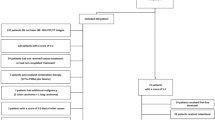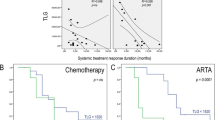Abstract
Objective
We aimed to evaluate whether baseline 68Ga-PSMA PET/CT-derived whole-body volumetric parameters could be used as predictive biomarkers for survival in metastatic castration-resistant prostate cancer (mCRPC) patients receiving first-line treatment.
Materials and methods
This retrospective study included 54 mCRPC patients, who underwent baseline 68Ga-PSMA PET/CT imaging within 1 month before starting first-line treatment. Pre-treatment prostate-specific antigen (PSA) levels and treatments were recorded. SUVmax, SUVmean, whole-body PSMA-derived tumor volume (wbPSMA-TV), and whole-body total lesion PSMA (wbTL-PSMA) were calculated for all patients. PSA response was defined as a decline of ≥ 50% from pre-treatment value at 12 weeks. Overall survival (OS) was measured from the start of the first-line treatment for mCRPC.
Results
Docetaxel and abiraterone/enzalutamide were administered to 32 and 22 patients in the first-line setting, respectively. wbPSMA-TV (rho = 0.582, p = 0.004) and wbTL-PSMA (rho = 0.564, p = 0.007) showed moderate positive correlations with PSA levels. Older age (p = 0.02), higher wbPSMA-TV (p = 0.007), higher PSA (p = 0.01), higher number of bone metastases (p = 0.02), and lack of PSA response (p = 0.03) were significantly associated with an increased risk of mortality. Multivariate analysis determined wbPSMA-TV (HR: 1.003, 95% CI 1.001–1.004, p = 0.001) and PSA response (HR: 2.241, 95% CI 1.189–4.222, p = 0.01) as independent predictors of OS.
Conclusion
The wbPSMA-TV may be a useful tool to reflect tumor burden and predict survival outcomes in patients with mCRPC.



Similar content being viewed by others
References
Sung H, Ferlay J, Siegel RL, Laversanne M, Soerjomataram I, Jemal A, et al. Global cancer statistics 2020: GLOBOCAN estimates of incidence and mortality worldwide for 36 cancers in 185 countries. CA Cancer J Clin. 2021;71(3):209–49.
SEER Cancer statistics: survival by stage in prostate cancer. Available from: https://seer.cancer.gov/statfacts/html/prost.html. Accessed 9 Nov 2021
Powers E, Karachaliou GS, Kao C, Harrison MR, Hoimes CJ, George DJ, et al. Novel therapies are changing treatment paradigms in metastatic prostate cancer. J Hematol Oncol. 2020;13(1):144.
Petrylak DP, Tangen CM, Hussain MH, Lara PN Jr, Jones JA, Taplin ME, et al. Docetaxel and estramustine compared with mitoxantrone and prednisone for advanced refractory prostate cancer. N Engl J Med. 2004;351(15):1513–20.
Berthold DR, Pond GR, Soban F, de Wit R, Eisenberger M, Tannock IF. Docetaxel plus prednisone or mitoxantrone plus prednisone for advanced prostate cancer: updated survival in the TAX 327 study. J Clin Oncol. 2008;26(2):242–5.
Ryan CJ, Smith MR, de Bono JS, Molina A, Logothetis CJ, de Souza P, et al. Abiraterone in metastatic prostate cancer without previous chemotherapy. N Engl J Med. 2013;368(2):138–48.
Ryan CJ, Smith MR, Fizazi K, Saad F, Mulders PF, Sternberg CN, et al. Abiraterone acetate plus prednisone versus placebo plus prednisone in chemotherapy-naive men with metastatic castration-resistant prostate cancer (COU-AA-302): final overall survival analysis of a randomised, double-blind, placebo-controlled phase 3 study. Lancet Oncol. 2015;16:152–60.
Beer TM, Armstrong AJ, Rathkopf DE, Loriot Y, Sternberg CN, Higano CS, et al. Enzalutamide in metastatic prostate cancer before chemotherapy. N Engl J Med. 2014;371:424–33.
Beer TM, Armstrong AJ, Rathkopf D, Loriot Y, Sternberg CN, Higano CS, et al. Enzalutamide in men with chemotherapy-naive metastatic castration-resistant prostate cancer: extended analysis of the phase 3 PREVAIL study. Eur Urol. 2017;71:151–4.
Kantoff PW, Higano CS, Shore ND, Berger ER, Small EJ, Penson DF, et al. Sipuleucel-T immunotherapy for castration-resistant prostate cancer. N Engl J Med. 2010;363:411–22.
Higano CS, Armstrong AJ, Sartor AO, Vogelzang NJ, Kantoff PW, McLeod DG, et al. Real-world outcomes of sipuleucel-T treatment in PROCEED, a prospective registry of men with metastatic castration-resistant prostate cancer. Cancer. 2019;125:4172–80.
Parker C, Nilsson S, Heinrich D, Helle SI, O’Sullivan JM, Fosså SD, et al. Alpha emitter radium-223 and survival in metastatic prostate cancer. N Engl J Med. 2013;369:213–23.
Ross JS, Sheehan CE, Fisher HA, Kaufman RP Jr, Kaur P, Gray K, et al. Correlation of primary tumor prostate-specific membrane antigen expression with disease recurrence in prostate cancer. Clin Cancer Res. 2003;9(17):6357–62.
Eiber M, Maurer T, Souvatzoglou M, Beer AJ, Ruffani A, Haller B, et al. Evaluation of hybrid 68Ga-PSMA ligand PET/CT in 248 patients with biochemical recurrence after radical prostatectomy. J Nucl Med. 2015;56(5):668–74.
Kratochwil C, Giesel FL, Stefanova M, Benešová M, Bronzel M, Afshar-Oromieh A, et al. PSMA-targeted radionuclide therapy of metastatic castration-resistant prostate cancer with 177Lu-labeled PSMA-617. J Nucl Med. 2016;57(8):1170–6.
Bagguley D, Ong S, Buteau JP, Koschel S, Dhiantravan N, Hofman MS, et al. Role of PSMA PET/CT imaging in the diagnosis, staging and restaging of prostate cancer. Future Oncol. 2021;17(17):2225–41.
Han S, Woo S, Kim YJ, Suh CH. Impact of 68Ga-PSMA PET on the management of patients with prostate cancer: a systematic review and meta-analysis. Eur Urol. 2018;74(2):179–90.
Afshar-Oromieh A, Avtzi E, Giesel FL, Holland-Letz T, Linhart HG, Eder M, et al. The diagnostic value of PET/CT imaging with the (68)Ga-labelled PSMA ligand HBED-CC in the diagnosis of recurrent prostate cancer. Eur J Nucl Med Mol Imaging. 2015;42(2):197–209.
Pyka T, Okamoto S, Dahlbender M, Tauber R, Retz M, Heck M, et al. Comparison of bone scintigraphy and 68Ga-PSMA PET for skeletal staging in prostate cancer. Eur J Nucl Med Mol Imaging. 2016;43(12):2114–21.
Aksu A, Karahan Şen NP, Tuna EB, Aslan G, Çapa KG. Evaluation of 68Ga-PSMA PET/CT with volumetric parameters for staging of prostate cancer patients [published correction appears in Nucl Med Commun. 2021 Oct 1;42(10):1186]. Nucl Med Commun. 2021;42(5):503–9.
Santos A, Mattiolli A, Carvalheira JB, Ferreira U, Camacho M, Silva C, et al. PSMA whole-body tumor burden in primary staging and biochemical recurrence of prostate cancer. Eur J Nucl Med Mol Imaging. 2021;48(2):493–500.
Brito AET, Mourato FA, de Oliveira RPM, Leal ALG, Filho PJA, de Filho JLL. Evaluation of whole-body tumor burden with 68Ga-PSMA PET/CT in the biochemical recurrence of prostate cancer. Ann Nucl Med. 2019;33(5):344–50.
Schmidkonz C, Cordes M, Schmidt D, Bäuerle T, Goetz TI, Beck M, et al. 68Ga-PSMA-11 PET/CT-derived metabolic parameters for determination of whole-body tumor burden and treatment response in prostate cancer. Eur J Nucl Med Mol Imaging. 2018;45(11):1862–72.
Karyağar S, Güven O, Karyağar SS, Arici S, Selvi O, Geredeli Ç, et al. Can 68Ga-PSMA PET/CT-derived prostate-specific membrane antigen expression parameters predict prostate-specific antigen response to enzalutamide treatment? Nucl Med Commun. 2021;42(9):1011–6.
Can C, Gündoğan C, Yildirim OA, Poyraz K, Güzel Y, Kömek H. Role of 68Ga-PSMA PET/CT parameters in treatment evaluation and survival prediction in prostate cancer patients compared with biochemical response assessment. Hell J Nucl Med. 2021;24(1):25–35.
Oruç Z, Güzel Y, Ebinç S, Kömek H, Küçüköner M, Kaplan MA, et al. Efficacy of 68Ga-PSMA PET/CT-derived whole-body volumetric parameters in predicting response to second-generation androgen receptor axis-targeted therapy, and the prognosis in metastatic hormone-refractory prostate cancer patients. Nucl Med Commun. 2021;42(12):1336–46.
Seifert R, Kessel K, Schlack K, Weber M, Herrmann K, Spanke M, et al. PSMA PET total tumor volume predicts outcome of patients with advanced prostate cancer receiving [177Lu]Lu-PSMA-617 radioligand therapy in a bicentric analysis. Eur J Nucl Med Mol Imaging. 2021;48(4):1200–10.
Charlson ME, Pompei P, Ales KL, MacKenzie CR. A new method of classifying prognostic comorbidity in longitudinal studies: development and validation. J Chronic Dis. 1987;40(5):373–83.
Hartrampf PE, Heinrich M, Seitz AK, et al. Metabolic tumour volume from PSMA PET/CT scans of prostate cancer patients during chemotherapy-do different software solutions deliver comparable results? J Clin Med. 2020;9:1390.
Schmidkonz C, Cordes M, Goetz TI, et al. 68Ga-PSMA-11 PET/CT derived quantitative volumetric tumor parameters for classification and evaluation of therapeutic response of bone metastases in prostate cancer patients. Ann Nucl Med. 2019;33:766–75.
Schmuck S, von Klot CA, Henkenberens C, Sohns JM, Christiansen H, Wester HJ, et al. Initial experience with volumetric 68Ga-PSMA I&T PET/CT for assessment of whole-body tumor burden as a quantitative imaging biomarker in patients with prostate cancer. J Nucl Med. 2017;58(12):1962–8.
Kim YI, Lee HS, Choi JY. Prognostic significance of pretreatment 18F-FDG PET/CT volumetric parameters in patients with colorectal liver metastasis: a systematic review and meta-analysis. Clin Nucl Med. 2021;46(3):206–13.
Bouron C, Mathie C, Seegers V, Morel O, Jézéquel P, Lasla H, et al. Prognostic value of metabolic, volumetric and textural parameters of baseline [18F]FDG PET/CT in early triple-negative breast cancer. Cancers. 2022;14(3):637.
Kyriakopoulos CE, Chen YH, Carducci MA, Liu G, Jarrard DF, Hahn NM, et al. Chemohormonal therapy in metastatic hormone-sensitive prostate cancer: long-term survival analysis of the randomized phase III E3805 CHAARTED trial. J Clin Oncol. 2018;36(11):1080–7.
Fizazi K, Tran N, Fein L, Matsubara N, Rodriguez-Antolin A, Alekseev BY, et al. Abiraterone plus prednisone in metastatic, castration-sensitive prostate cancer. N Engl J Med. 2017;377(4):352–60.
James ND, Sydes MR, Clarke NW, Mason MD, Dearnaley DP, Spears MR, et al. Addition of docetaxel, zoledronic acid, or both to first-line long-term hormone therapy in prostate cancer (STAMPEDE): survival results from an adaptive, multiarm, multistage, platform randomised controlled trial. Lancet. 2016;387(10024):1163–77.
Vaz S, Hadaschik B, Gabriel M, Herrmann K, Eiber M, Costa D. Influence of androgen deprivation therapy on PSMA expression and PSMA-ligand PET imaging of prostate cancer patients. Eur J Nucl Med Mol Imaging. 2020;47(1):9–15.
Tseng JR, Chang SH, Wu YY, et al. Impact of three-month androgen deprivation therapy on [68Ga]Ga-PSMA-11 PET/CT indices in men with advanced prostate cancer-results from a pilot prospective study. Cancers (Basel). 2022;14(5):1329.
Zhang Q, Han Y, Zhang Y, Liu D, Ming J, Huang B, Qiu X. treatment-emergent neuroendocrine prostate cancer: a clinicopathological and immunohistochemical analysis of 94 cases. Front Oncol. 2021;1(10): 571308.
Okasho K, Ogawa O, Akamatsu S. Narrative review of challenges in the management of advanced neuroendocrine prostate cancer. Transl Androl Urol. 2021;10(10):3953–62.
-National Comprehensive Cancer Network. Prostate Cancer (Version 4.2022). https://www.nccn.org/professionals/physician_gls/pdf/prostate.pdf Accessed 30 May 2022
Shen K, Liu B, Zhou X, et al. The evolving role of 18F-FDG PET/CT in diagnosis and prognosis prediction in progressive prostate cancer. Front Oncol. 2021;11: 683793.
Derlin T, Werner RA, Lafos M, et al. Neuroendocrine differentiation and response to PSMA-targeted radioligand therapy in advanced metastatic castration-resistant prostate cancer: a single-center retrospective study. J Nucl Med. 2020;61(11):1602–6.
Bakht MK, Hayward JJ, Shahbazi-Raz F, et al. Identification of alternative protein targets of glutamate-ureido-lysine associated with PSMA tracer uptake in prostate cancer cells. Proc Natl Acad Sci USA. 2022;119(4): e2025710119.
Funding
The authors did not receive support from any organization for the submitted work.
Author information
Authors and Affiliations
Corresponding author
Ethics declarations
Conflict of interest
The authors declared no competing interest.
Ethical approval
This retrospective study was approved by the Marmara University ethics committee (Date of approval: 24 July 2020, Protocol Code: 09.2020.888).
Additional information
Publisher's Note
Springer Nature remains neutral with regard to jurisdictional claims in published maps and institutional affiliations.
Supplementary Information
Below is the link to the electronic supplementary material.
Rights and permissions
Springer Nature or its licensor holds exclusive rights to this article under a publishing agreement with the author(s) or other rightsholder(s); author self-archiving of the accepted manuscript version of this article is solely governed by the terms of such publishing agreement and applicable law.
About this article
Cite this article
Telli, T.A., Ozguven, S., Alan, O. et al. Role of baseline 68Ga-PSMA PET/CT-derived whole-body volumetric parameters in predicting survival outcomes of metastatic castration-resistant prostate cancer patients receiving first-line treatment. Ann Nucl Med 36, 964–975 (2022). https://doi.org/10.1007/s12149-022-01785-x
Received:
Accepted:
Published:
Issue Date:
DOI: https://doi.org/10.1007/s12149-022-01785-x




